Laser hair removal
Laser Lightsheer Duet
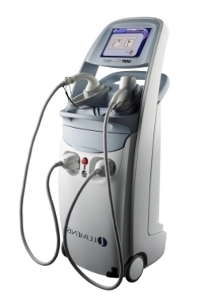 Diode laser Lightsheer Duet produced by American company - Lumenis, is currently state of the art and the best device for laser hair removal in the world, and consequently, offering the best results of epilation. The method of laser hair removal is permanent, safe and practically painless. It is a non-invasive technique, which does not damage skin. Lightsheer Duet is a revolutionary and reliable device, guaranteeing effectiveness and desired results. It saves patient's pain, unpleasant and time-consuming recovery and it completely solves the problem of unwanted body hair. LightSheer Duet system is equipped with two heads emitting diode laser
light with a wavelength of 800 nm, which enables high-speed and safe treatment, also in patients with dark complexion and tanned skin.
Diode laser Lightsheer Duet produced by American company - Lumenis, is currently state of the art and the best device for laser hair removal in the world, and consequently, offering the best results of epilation. The method of laser hair removal is permanent, safe and practically painless. It is a non-invasive technique, which does not damage skin. Lightsheer Duet is a revolutionary and reliable device, guaranteeing effectiveness and desired results. It saves patient's pain, unpleasant and time-consuming recovery and it completely solves the problem of unwanted body hair. LightSheer Duet system is equipped with two heads emitting diode laser
light with a wavelength of 800 nm, which enables high-speed and safe treatment, also in patients with dark complexion and tanned skin.
Why LightSheer Duet Laser? Benefits for patients.
There are at least a few systems for hair removal available on the market, and they largely differ in effectiveness. We offer our patients a top level service. Our priorities while choosing the right laser were the following:
- maximum efficiency
- safety
- comfort for the patient
- short time of a single session
- relatively small number of treatments to achieve satisfying results
Diode laser Lightsheer Duet is the top level device for unwanted body hair removal. The company exists from 1966 and is the worldwide leader in medical and cosmetic laser systems. Diode Laser System has a safety and quality certificate issued by the U.S. FDA (U.S. Department of the Food and Drug Administration), respected around the world.
The latest version of LightSheer - LightSheer Duet - consists of two hand pieces:
 LightSheer ET treatment head - to maximise the treatment safety, the hand piece has a unique cooling system, the so-called ChillTip. It is integrated in the small head and in this way, the treatment is skin friendly, comfortable and protects the skin during the treatment, making the procedure less painful. All the time during the session, the temperature of the sapphire tip is maintained at 4°C. In this way, it is a much more efficient cooling, compared with the solutions applied in other devices for hair removal (air-cooling, gels, etc.);
LightSheer ET treatment head - to maximise the treatment safety, the hand piece has a unique cooling system, the so-called ChillTip. It is integrated in the small head and in this way, the treatment is skin friendly, comfortable and protects the skin during the treatment, making the procedure less painful. All the time during the session, the temperature of the sapphire tip is maintained at 4°C. In this way, it is a much more efficient cooling, compared with the solutions applied in other devices for hair removal (air-cooling, gels, etc.);
 LightSheer HS treatment head - entirely new, innovative technology, combining large spot size of 22x35 mm with vacuum pressure, which acts analgesically and increases penetration of the laser beam, deeply into the hair follicle. LightSheer HS reduces treatment time of leg hair removal from about 2 hours to about 30 minutes;
LightSheer HS treatment head - entirely new, innovative technology, combining large spot size of 22x35 mm with vacuum pressure, which acts analgesically and increases penetration of the laser beam, deeply into the hair follicle. LightSheer HS reduces treatment time of leg hair removal from about 2 hours to about 30 minutes;
Comparison of spot sizes and the depths of laser beam penetration in two LightSheer Duet handpieces:
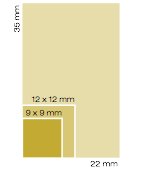 |
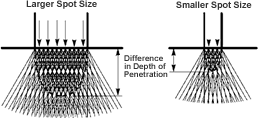 |
LightSheer Duet has regulated pulse duration from 30 to 400 ms, which enables performance of reliable treatments of hair removal for all skin phototypes (I-VI, according to the Fitzpatrick Skin Types) including the suntanned skins.
Benchmark tests for lasers:
1. Ruby laser - wavelength 694 nm, applied energy form 10 to 60J/cm2, pulse duration from 0,05 to 22 ms, spot size 4x10 mm.
2. Alexandrite laser - wavelength 755 nm, applied energy form 25 to 40 J/cm2, pulse duration from 2 to 20 ms, spot size 5x10 mm.
3. Nd-Yag laser - wavelength 1064 nm, applied energy form 2.5 to 40 J/cm2, pulse duration from 15 to 50 ms, spot size 7 mm.
4. Diode laser of „older generation” - wavelength 810 nm, applied energy form 40 to 60 J/cm2, pulse duration from 30 to 100 ms, spot size 9x9 mm or 12x12 mm.
5. Diode laser of „new generation” - LightSheer Duet - wavelength 800 nm, energy: small head up to 100 J/cm2, large head up to 12 J/cm2, pulse duration from 30 to 400 ms, spot size - in large head 22x35 mm.
Mechanism of action of the laser light on the hair follicle and hair
Laser applied for hair removal operates superficially and does not affect the whole body functioning. The laser beam, directed to the skin, penetrates 2 mm into the skin, which causes firstly, damaging the hair follicle and then its gradual disappearance, which in turn leads to the hair loss. The laser-emitted radiation is absorbed by the melanin of the hair follicle and skin. Appropriate pulse length destroys the targeted melanin, thereby resulting in loss of stem cells of the hair follicles and the hair vanish without a trace.
With the small laser head, a single laser shot is enough to eliminate several or even more hair, located on the skin surface of a 9x9 mm spot. Laser hair removal is a gradual process, which reduces hair, spot after spot.

The large laser head operates a different mechanism:
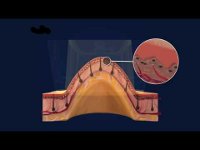 1) vcuum gently draws skin into hand piece, causing reduction in density of melanocytes in the skin, and, as a result. less energy is absorbed by the epidermis and more by the hair melanin,
1) vcuum gently draws skin into hand piece, causing reduction in density of melanocytes in the skin, and, as a result. less energy is absorbed by the epidermis and more by the hair melanin,
2) vacuum pressure eliminates the perception of the nerve endings and so the treatment is almost painless,
3) vacuum pressure constricts blood vessels and less energy is absorbed by oxyhemoglobin;

When is laser hair removal applied?
- to eliminate unwanted hair resulting from endocrine disorders - hirsutism, hypertrichosis,
- for cosmetic purposes - all body areas,
- in patients with ingrown hair symptoms, occuring after other methods of epilation,
- in patients with vascular lesions on legs,
- patients with sensitive skin, who experience skin inflammation effect (redness) after waxing, shaving or chemical epilation,
- the treatment is suitable for men in cases of skin hypersensitivity after shaving (thinning out),
Laser hair removal - effects
Not all hair grows simultaneously. A part of it is always in the active stage of growth (anagen phase) - it's hair that can be seen on the skin surface. Only the hair being in the growth phase may be destroyed by the laser light. The remaining hair remains dormant (telogen phase), anywhere from 3–8 weeks. The telogen phase is followed by the growth phase (anagen), when the hair may be again actively destroyed with laser. Therefore, the sessions of laser hair removal need to be repeated (about 4-6 times) in order to eliminate nearly all hair. During the first treatment with LigtSheer laser, about 20%-30% of hair is removed, while after a series of sessions - up to 90%. The remaining hair is distinctly lighter, softer and almost invisible and usually do not bother patients. Considering the earlier undergone treatments of wax epilation, hair removal with mechanical epilator or a tweezer, etc. or in the case of excessive hair caused by hormonal disorders, it may be sometimes necessary to undergo more sessions of laser hair removal, in order to obtain even better results, and then take maintaining sessions, e.g. once a year.
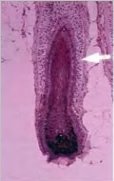
|
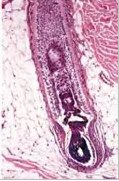 |
anagen hair before |
anagen hair immediately after |
Przykłady efektów poprocedureowych: laserowe usuwanie owłosienia
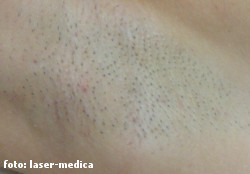 armpits before |
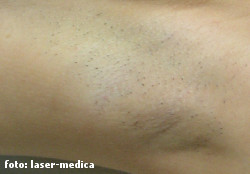 armpits after 3 sessions |
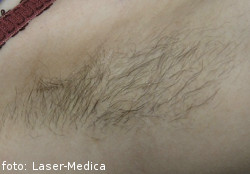 armpits before |
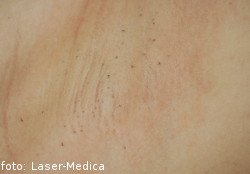 armpits after 4 sessions |
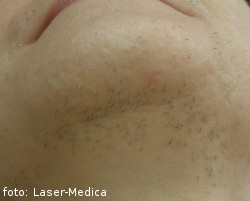 the submandibular trigone before |
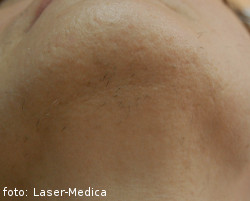 the submandibular trigone after |
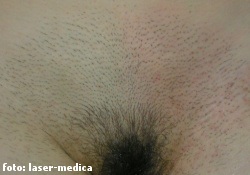 bikini before |
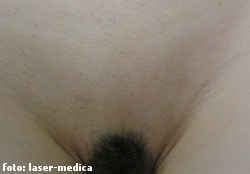 bikini after |
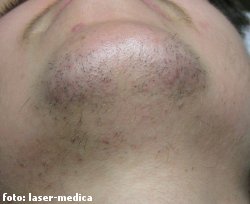 before |
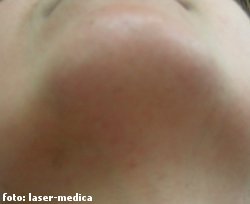 after |
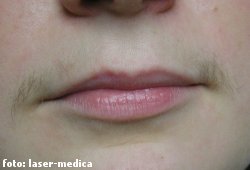 before |
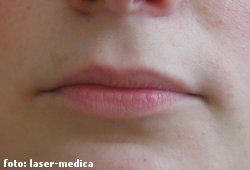 after |
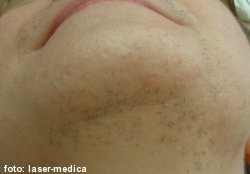 before |
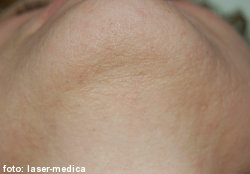 after |
*Copying and spreading of the photos without the consent of the owner is prohibited!
Frequently Asked Questions
How does laser hair removal work?
The laser light is calibrated to target the dark pigment of the hair follicle (melanin). It heats the hair structure up to 70ºC and the intense heat destroys it.
What hair type can be treated?
The hair with high amounts of melanin (black). Since the laser light targets the darkest areas, the tone of skin is also significant. The lighter skin and the darker hair (bigger contrast), the better results.
Why do the treatments have to be repeated?
Because not all hair are in the same phase of the hair growth cycle at a given time - each strand of hair on the human body is at its own stage of development. A single hair undergoes successively: growth phase, transitional phase and resting phase. Laser light may only work against hair being in the growth phase, namely the ones that we see on the skin surface. Transition of hair from one phase to another is not concurrent (as it is in case of some animals undergoing molting), therefore, a series of sessions is recommended.
How many treatments will be necessary to get rid off unwanted hair?
Depending of the applied laser systems, the number of required treatments varies from 3 to 10. With LightSheer diode laser, on average, 4-5 sessions are needed.
Will the hair be eliminated permanently?
Laser hair removal is approved for permanent, but partial hair reduction. Permanent hair reduction involves up to 80-90% of hair. The remaining hair may grow back during lifetime, however, it will be thinned out, softer and lighter.
What if after a series of treatment the hair is not reduced?
It might result from the presence of a factor stimulating the growth of new hair follicles. In most cases, it is due to the presence of hormonal disorders.
Concerning the above, should the patients with hirsutism avoid laser hair removal treatment?
Definitely no, however, they should simultaneously follow the instructions from their endocrinologist or gynaecologist. Patients with hirsutism need to accept potential necessity of performing more sessions than in a usual course of treatment as well as eventual repetition of treatment in the future.
What should I do to prepare my skin before my treatment?
The most important recommendations are not to tan and remove your hair mechanically, at least a month before the planned treatment. The day before surgery, you should shave the hair.
Why shouldn't the target skin be tanned?
It is important, because sunbathing stimulates the melanin production in the epidermis. Laser is absorbed by melanin, however, it is desired, that it is the hair melanin. If the laser light comes across melanin before reaching the hair melanin - in epidermis (while hair is rooted deeper) - a significant part of energy will be absorbed by the epidermis melanin, and not by the hair melanin. As a result, the treatment will not bring the expected effects, and, additionally, will cause epidermis burns. The newest LightSheer Duet system offers the possibility of performing hair removal in patients with very dark skin, due to long pulse duration and the vacuum pressure function, which reduces the density of epidermal melanin. However, the producer does not recommend performing the treatment on the
skin with a fresh tan, and so, it is advised to wait for about a month from the last UV exposure, before undergoing the laser hair removal treatment.
Why the hair should not be mechanically removed before laser hair removal?
During tweezing, waxing or epilating skin with a mechanical device, we remove the hair shaft, which contains melanin. Therefore, the laser is left with no object to operate on. While in the dermis, there are still hair germ cells left, and so the hair will surely regrow.
For how long before laser hair removal should I grow may hair?
There is no need to grow one's hair, it is only recommended to stop mechanical hair removal, in case of hair growing on the face, for about one month before the planned treatment, and, in case of hair on other body parts, for about 1,5-2 months. It means, that during this time, you should not use wax, tweezers or mechanical depilator. Patients are allowed to shave or to use depilatory creams or foams. Sometimes patients cannot wait for so long and come for their treatment earlier, with less hair. Then, they need to accept that the treatment effectiveness may be lower and that it might be necessary for them to undergo more laser hair removal sessions.
Why should the hair in the target area be shaved immediately before the treatment?
During the procedure, if the external hair shaft is present, the laser will burn it, which in turn may lead to burning the skin. Additionally, such treatment will be less effective, because a part of the energy emitted by the laser will be absorbed by the hair shaft and not by the hair, which is placed deeper in the skin (where also the cells responsible for the hair regrowth are placed).
What does the procedure of laser hair removal look like?
During the procedure, the doctor places the laser head on the patient's shaved and cleaned skin. The head has a built-in laser spot (in case of LightSheer Duet it has a form of a 9x9 mm square or a 22x35mm rectangle), emitting laser beam. The head is then placed next to one another and the whole area covered with hair is treated.
Is the procedure painful?
When the pulse of light is delivered, some patients experience a mild pinching or stinging sensation. Since not all people have the same pain threshold, it depends on the skin sensitivity, target treatment area, colour and thickness of the hair. No local anaesthesia or pain medication is typically required, however some patients may prefer to use a topical anaesthetic (e.g. EMLA cream) when sensitive areas are treated. The head of LightShher Duet is equipped with a sapphire touch cooling system, which cools the skin, acting like an additional anaesthetic. Moreover, a cold gel may be applied to relieve any discomfort to the area.
What does the skin look like after treatment?
Immediately after the procedure, it is common for the treated area to have some redness, which should disappear over the next 2-3 hours. Additionally, there may appear redness and swelling of the hair follicle. This is, again, a desired clinical endpoint, seen with most laser hair removal procedures. Laser hair removal treatment do not exclude patients form their everyday life. Following the treatment, they can return to their normal activities right away, meaning get back to work, school, etc.
What are the recommendations after treatment?
The most important recommendation is not to tan your skin (for at least 4 weeks after the treatment) as there is a risk of skin discolouration. Additionally, for a few days following the treatment, you should not use any alcohol-based skin care products and attend swimming pools, considering possible skin irritation caused by chlorinated water.
Can I wear make-up after laser hair removal?
Immediately after the procedure, it is best recommended to avoid make-up, so as not to irritate the epidermis. However, make-up may be applied the following day, as long as there is no redness on the skin. Contraindication to wearing make-up is the occurrence of any complications.
What complications are possible after the treatment?
It is vital, that complications after the LightSheer diode laser are extremely rare. Most often they relate to skin burns and include blisters and scabs. Other, rarer conditions are related to pigmentation disorders and are known as hyperpigmentation or hypopigmentation. There is also a risk of bacterial and viral skin infections, as the treatment is directed to the epidermis. Nearly all complications are curable and leave the treated skin without permanent scaring results. Regarding the above, it is very important, that the laser hair removal treatments are performed by adequately trained technicians, always supervised by a dermatologic surgeon (consultation with a proper qualification, matching the right laser parameters, planning the reatment of potential complications).
Laser hair removal has become a cosmetic procedure, which is more and more often offered by beauty salons. Why is a doctor's control needed?
Above all, a dermatologic surgeon qualifies for the treatment, eliminates contraindications, cooperates with an endocrinologist during treatment of patients with hirsutism, matches the right pulse duration and fluence to specific patient during the procedure. After the treatment, the surgeon should examine the treated skin and, if necessary, recommend a proper skin care procedures, especially, if there are any adverse effects.
What happens to hair after treatment?
The hair damaged (carbonized by the laser) during the procedure, is being shed from the hair follicle to the skin surface, and patients may believe that their hair is regrowing. During this period, if the damaged hair is particularly bothering (rough and stiff), it can be shaved. Nonetheless, most of them (more than 80%) fall out of skin after about 2-4 weeks. The skin becomes smooth (or almost smooth) and stays in this state, until successive hair proceeds from the resting phase to the growth phase. As the resting phases differ with regard to the anatomical areas, the time interval before follow-up treatments will be different. For the face, it is usually after about 4-6 weeks, on other sites, such as the back, after about 6-8 weeks, and on legs, the growth delay is usually two to three months.
When will I notice hair reduction?
Hair reduction takes place during each session. Each time, about 20-30% of hair is eliminated. Patients can actually notice the hair reduction effects, when it becomes more spectacular, meaning when the percentage of hair reduction reaches about 50%, which is usually after 3rd procedure.
How to get rid of grey hair?
For grey, blond or red hair lasers will not be effective, as such hair do not contain melanin. At present, there are attempts to dye the hair with special substances which deeply penetrate the skin. Unfortunately, this method is relatively expensive, not fully tested yet and not without certain side effects. Therefore, it is difficult to comment on its effectiveness.
Are there any alternative methods for light hair reduction?
If these are single strings of hair, electrolysis can be tried, as this method involves inserting a needle into each individual hair follicle, and delivering an electrical charge to them one at a time, while the hair colour is of no significance. However, this method in nowadays rarely used, as it is an invasive, painful process and entails the risk of complications. It is very tedious, requires high precision and a lot of time, and when setting too high power, the patient may experience complications such as scarring and keloid scars.
Can I expect permanent effects after a completed series of laser hair removal treatments?
As it was mentioned above, after a full series of laser hair reduction, we may permanently eliminate about 80-90% of hair. The remaining percent of 10-20, is the hair that may appear during lifetime. In women, it will usually take place during critical periods in life, connected with changes in hormonal balance, such as: pregnancy, taking hormonal medications or during menopause. It is however few hair, which may be also eliminated with laser, if necessary.

